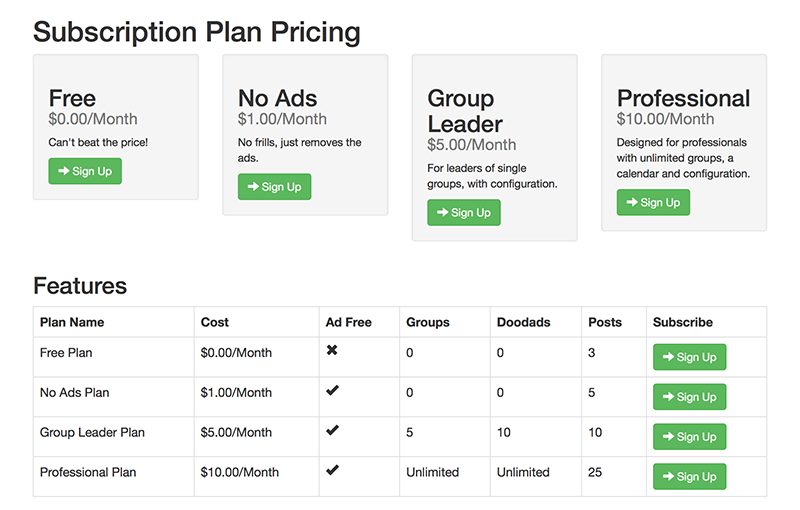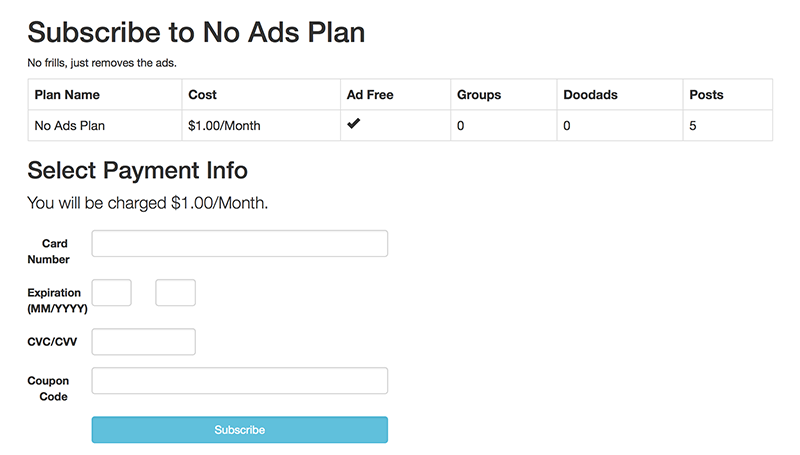Paid Up is a start-to-finish Stripe subscription engine. You set up the plans and coupons you want on Stripe, and the gem gives you a way to tie those plans and coupons to authenticated users, granting them abilities based on the features outlined for their plan.
- Ruby 2, Rails 4 through Rails 6
- Authentication by Devise
- Authorization by CanCanCan
- Subscription by Stripe
- Roles by Rolify
- Uses Google Tag Manager for Google Analytics
dataLayerobject to provide e-commerce analytics. - Assumes you will be using some variety of Bootstrap, and designed to be quite responsive out of the box. Included views can be overridden with custom views.
First, add paid_up to your Gemfile:
gem 'paid_up'
To start with, you will need a User model and the corresponding table, set up with your business rules for users, such as profile fields or theme configuration.
rails generate model User name:string:unique bio:text
Next, install PaidUp for your user model by executing these commands:
bundle install
rails g paid_up:install
rake db:migrate
Edit your config file at config/initializers/paid_up.rb to set up some other key details.
Set your environment variables with your STRIPE_PUBLISHABLE_KEY and STRIPE_SECRET_KEY. (Check your operating system or IDE's documentation for details. I use the gem dotenv for this.)
Using your own code or Stripe's convenient web interface, add the plans and coupons you intend to offer.
Each plan will also need a record in your own database, so for each Stripe::Plan you create, note the id and use it as the stripe_id in the corresponding PaidUp::Plan. At a minimum, you will need an anonymous plan, a free plan, both with a cost amount of 0; and also at least one paid plan.
Coupons do not need any further configuration, other than adding them to your Stripe Account.
Next, add a Stripe::Customer to serve as the Anonymous User, and subscribe that customer to the anonymous plan. Note the customer's id and copy that into your stripe configuration file.
Pay close attention to the settings in Account Settings under Subscriptions and Emails, as they have a big effect on how your site behaves.
Set up each PaidUp::Feature using the config file. (A config file is used rather than using records in an ActiveRecord::Base model because relationships cannot be created at runtime.) Associate the features with the corresponding plans using the PaidUp::PlanFeatureSetting model. For an example, check out the seeds file at spec/dummy/db/seeds.db
Possible :setting_type values are: boolean, table_rows, rolify_rows. The latter two require a table corresponding to the feature's :name value.
In the table_rows case, the table and its model must exist. the table should have a :user_id column, then you need to add paid_for to the model, and from there the appropriate has_many and belongs_to relationships will be created for you.
In the rolify_rows case, the table and its model must also exist. Once that is done and the corresponding PaidUp::Feature is created, add paid_for to the model. This means the resource model will run the resourcify method, and the User method will have had the rolify method added to it during install, so no further setup is required.
If you only want to count certain records against a user's tally, for example only records with active set to true, you can add the scope option with a symbol corresponding to the desired method or scope, like so:
class Post < ActiveRecord::Base
paid_for scope: :active
scope :active, -> { where(active: true) }
end
In order for PaidUp's AJAX functionality to work (which is required because Stripe uses AJAX), you will need to add this to your layout file, preferably near the end of the element (for speed reasons):
= render_footer_javascript
Abilities corresponding to features you have defined will be generated automatically, as an :own ability on the specified tables, plus rational defaults for :manage, :index and :show permissions, if you include the PaidUp::Ability module and use the initialize_paid_up(user) command, like this:
# /app/models/ability.rb
class Ability
include CanCan::Ability
include PaidUp::Ability
def initialize(user)
user ||= User.new # anonymous user (not logged in)
# Rails Application's initialization could go here.
initialize_paid_up(user)
end
end
If you try generating a list of users (such as for display in a user directory), you may find that the Stripe checking code slows down your query significantly.
To avoid this, add "select(:field_1, :field_2, :etc)" to your finder, being sure to omit the :stripe_id column.
Another option would be to create a Person model that inherits from the User model but omits the :stripe_id column
(as above) in its default_scope. You can use this Person object for queries related to directory or profile display,
thereby speeding up all queries not requiring plan information.
Your controller should inherit from PaidUp::PaidUpController, which in turn inherits from your own ApplicationController.
class GroupsController < PaidUp::PaidUpController
Your user model will need to call the subscriber method (this is done for you at install).
The resources referred to in your config will need to call paid_for, like this:
class Group < ActiveRecord::Base
paid_for
end
In your application controller, add:
helper PaidUp::PaidUpHelper
In your layout view, include the following code snippet, which will only fire when a subscription is made.
This needs to go above your call to Google Tag Manager, so that the data in it is available to GTM.
= paid_up_google_analytics_data_layer
Doing this will populate the e-commerce data in Google Analytics, but you must also have that feature turned on.
Renamed subscription to paid_up_subscription and subscriptions to paid_up_subscriptions to avoid naming conflicts with other gems.
Version 0.12.0 requires Ruby 2.3 or higher because of the use of the &. operator.
The methods table_rows and rolify_rows were renamed to table_setting(table_name).rows_count and rolify_setting(table_name).rows_count, replaced by methods that fetch the rows themselves.
All previous methods beginning with table_rows_ and rolify_rows_ have also been moved into table_setting() and rolify_setting()
The method enabled was renamed to enabled?.
Version 0.9.0 enabled coupon codes, which are saved on the user's record. Be sure to run rake paid_up:install:migrations and migrate your database after upgrading.
Version 0.8.0 introduced database changes to the foreign key columns to work with namespacing in Rails 4.2.5:
paid_up_plan_feature_settings.plan_id must be changed to paid_up_plan_feature_settings.paid_up_plan_id.
- Check out the latest master to make sure the feature hasn't been implemented or the bug hasn't been fixed yet.
- Check out the issue tracker to make sure someone already hasn't requested it and/or contributed it.
- Fork the project.
- Start a feature/bugfix branch.
- Commit and push until you are happy with your contribution.
- Make sure to add tests for it. This is important so I don't break it in a future version unintentionally.
- Please try not to mess with the Rakefile, version, or history. If you want to have your own version, or is otherwise necessary, that is fine, but please isolate to its own commit so I can cherry-pick around it.
Copyright (c) 2015-2017 Gem Vein. See LICENSE.txt for further details.


